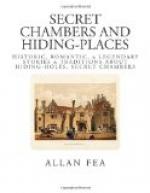There are still certain “priests’ holes” in the house, but the most interesting hiding-place is situated in the most innocent-looking of summer-houses in the grounds. The interior of this little structure is wainscoted round with large panels like most of the summer-houses, pavilions, or music-rooms of the seventeenth century, and nothing uncommon or mysterious was discovered until some twenty-five years ago. By the merest accident one of the panels was found to open, revealing what appeared to be an ordinary cupboard with shelves. Further investigations, however, proved its real object. By sliding one of the shelves out of the grooves into which it is fixed, a very narrow, disguised door, a little over a foot in width, in the side of the cupboard and in the thickness of the wall can be opened. This again reveals a narrow passage, or staircase, leading up to the joists above the ceiling, and thence to a recess situated immediately behind the carved ornamental facing over the entrance door of the summer-house. In this there is a narrow chink or peep-hole, from which the fugitive could keep on the look-out either for danger or for the friendly Royalist agent of the “King’s Arms.”
When it was first discovered there were evidences of its last occupant—viz. a Jacobean horn tumbler, a mattress, and a handsomely worked velvet pillow; the last two articles, provided no doubt for the comfort of some hunted cavalier, upon being handled, fell to pieces. It may be mentioned that the inner door of the cupboard can be securely fastened from the inside by an iron hook and staple for that purpose.
Hewitt, mine host of the “King’s Arms,” was not idle at the time transactions were in progress to transfer Charles II. from Trent to Heale, and received within his house Lord Wilmot, Colonel Phelips, and other of the King’s friends who were actively engaged in making preparations for the memorable journey. This old inn, with its oak-panelled rooms and rambling corridors, makes a very suitable neighbour to the more dignified old brick mansion opposite, with which it is so closely associated.
[Illustration: SECRET CHAMBER, CHASTLETON, OXFORDSHIRE]
[Illustration: OLD SUMMER HOUSE, SALISBURY (SHEWING CARVING IN WHICH IS A PEEP-HOLE FOR HIDING-PLACE BEHIND)]
Many are the exciting stories related of the defeated Royalists, especially after the Worcester fight. One of them, Lord Talbot, hastened to his paternal home of Longford, near Newport (Salop), and had just time to conceal himself ere his pursuers arrived, who, finding his horse saddled, concluded that the rider could not be far off. They therefore searched the house minutely for four or five days, and the fugitive would have perished for want of food, had not one of the servants contrived, at great personal risk, to pay him nocturnal visits and supply him with nourishment.
The grey old Jacobean mansion Chastleton preserves in its oak-panelled hall the sword and portrait of the gallant cavalier Captain Arthur Jones, who, narrowly escaping from the battlefield, speeded homewards with some of Cromwell’s soldiers at his heels; and his wife, a lady of great courage, had scarcely concealed him in the secret chamber when the enemy arrived to search the house.




